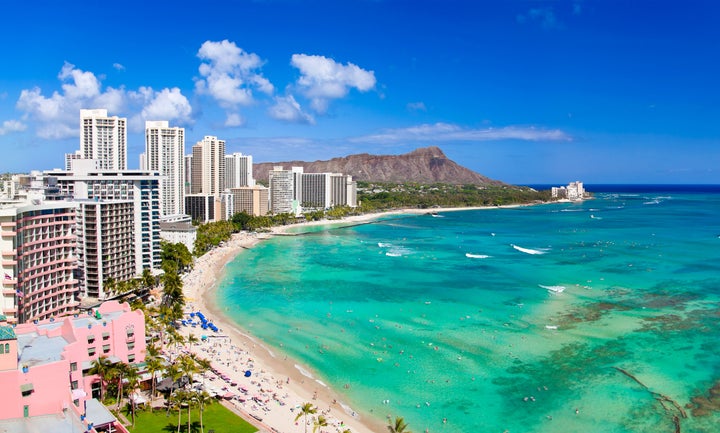
Since the coronavirus hit the U.S., roughly 40% of U.S. employees now work from home. If you’re one of them, you may be fantasizing about trading your boring apartment walls and modest desk for tropical air and sandy beaches.
A new program known as Movers and Shakas is offering just that: A free round trip to Hawaii for remote workers in exchange for a few hours of community service.
The program was launched through a partnership that includes the Hawaii state government, business leaders, alumni associations and organizations including the Central Pacific Bank Foundation, Hawaii Executive Collaborative, Island Holdings, Inkinen and FCH Enterprises, the parent company of Zippy’s restaurants, according to a press release. The goal? Diversifying Hawaii’s economy amid business shutdowns and decreased tourism.
“Now that many people have the choice to work remotely, there’s an opportunity for former local residents to return home and for out-of-state individuals and families to live and work from Hawaii for a longer period of time,” said Jason Higa, CEO of FCH Enterprises. “We believe this program will attract many former Hawaii residents and professionals seeking a safe, warm environment to continue living their normal lives while contributing to the Hawaii community.”
So what’s the catch, you’re asking? There isn’t one, necessarily, but it does require some planning (and maybe saving) to participate. Here’s a closer look at the initiative.
How Do I Qualify For A Free Trip To Hawaii?
First, you must be a U.S. resident and at least 18 years old to apply. You must also be employed and work remotely, or have the option to do so. Current residents of Hawaii can’t participate at this time.
You must be able to move to Oahu within a month if you’re selected for the program, as well as stay there full-time for at least 30 consecutive days. You also need to commit 15 hours a week to volunteer work with local partners, which include the Chamber of Commerce, Girl Scouts of Hawaii and the Pacific-Asian Center for Entrepreneurship at UH Mānoa. Program participants are also asked to sign the “Pledge to Our Keiki,” a commitment to treating the lands and waters with respect.
You have until Dec. 15 to apply for the program. Fifty participants will be chosen (selection criteria is still in the works) and additional participants will be added on a rolling basis. Those who get picked receive free round-trip airfare to Hawaii, as well as other perks.
Members of the same household, such as couples and families, are encouraged to apply, too. If you have pets that you plan to bring, however, keep in mind that traveling to the island and securing housing will require extra time and planning.
Is There Any Cost To Participate?
Though the program is free, including your plane ticket to and from Hawaii, there are a number of expenses you’ll need to plan for.
The program offers significantly discounted rates on hotels, as well as some potential discounts on long-term rentals such as Airbnb. However, housing is a cost you ultimately have to shoulder. If you also have a rent or mortgage payment to make back home, you could be doubled-up on housing costs for the month (or longer) you’re there.
Transportation is another expense to consider. Oahu is a sprawling island that requires a car to get around. And you’ll definitely want to check out landmarks such as Diamondhead, Hanauma Bay and the North Shore while you’re there. That means budgeting for a rental or relying on rideshare services and other public transportation. One option you probably don’t want to consider is having your car shipped, which costs about $1,000-$1,500 each way.
You’ll also be responsible for food, entertainment and any other expenses you incur as a short-term resident of the island. Also be sure to check with your accountant, as earning income in one state while you live in another could add to your tax bill next year.
What About The COVID-19 Pandemic?
Sure, a monthlong work vacation in Hawaii sounds like a dream. But what about this pesky pandemic that’s put a damper on travel, eating out and being within six feet of another human?
Hawaii is pretty serious about keeping new coronavirus cases off its islands. As a result, the state has the fewest cases per capita in the U.S. When you get there, you must test negative for the virus within 72 hours of landing or else self-isolate for two weeks.
Still, life on Oahu is far from pre-pandemic existence. The island follows a four-tier system to determine which businesses can operate. Currently, it’s only at Tier 2, which means that most businesses, such as restaurants, gyms and salons, can open with significantly limited capacity. Bars and clubs are closed.
As for the volunteer work that’s required, it’s unclear whether the program will offer virtual options or if you must show up in person. Program leaders didn’t respond to request for comment.
Ultimately, there is some risk involved with traveling to Hawaii to work and volunteer. You’ll have to consider your personal comfort level. And, of course, that’s assuming you are picked for the program in the first place.
